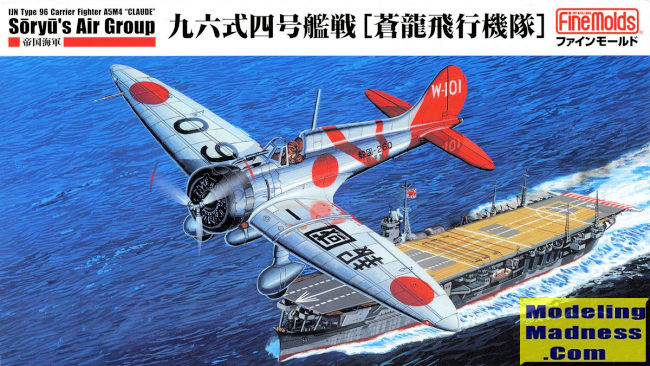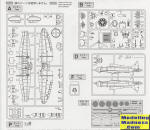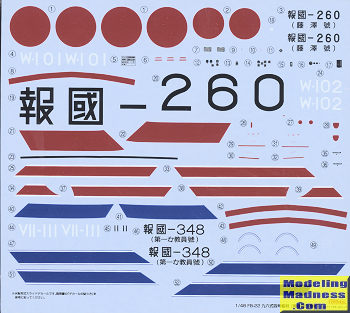
Fine Molds 1/48 A5M4 'Claude' - Soryu Air Group
| KIT #: | FB 22 |
| PRICE: | 3060 yen |
| DECALS: | Three options |
| REVIEWER: | Scott Van Aken |
| NOTES: | 2016 tooling |

| HISTORY |
The aircraft entered service in early 1937, soon seeing action in pitched aerial battles at the start of the Second Sino-Japanese War, including air-to-air battles with the Republic of China Air Force's Boeing P-26C Model 281 "Peashooters" in what was the world's first-ever aerial dogfighting and kills between monoplane fighters built of mostly metal.
Chinese Nationalist pilots, primarily flying the Curtiss Hawk III, put up a valiant fight against the Japanese, but the A5M was the better of almost every fighter aircraft it encountered. Though armed with only a pair of 7.7 mm machine-guns, the new fighter proved effective and damage-tolerant, with excellent maneuverability and robust construction. Later on A5M's also provided much-needed escorts for the then-modern but vulnerable Mitsubishi G3M bombers.
The Mitsubishi team continued to improve the A5M, working through versions until the final A5M4, which carried an external underside drop tank to provide fuel for extended range.
The A5M's most competitive adversary in the air was the Polikarpov I-16, a fast and heavily armed fighter flown by both Chinese Air Force regulars and Soviet volunteers. Fierce air battles in 1938, especially on 18 February and 29 April, ranked among the largest air battles ever fought at the time. The battle of 29 April saw 67 Polikarpov fighters (31 I-16s and 36 I-15 bis) against 18 G3Ms escorted by 27 A5Ms. Each side claimed victory: the Chinese/Soviet side claimed 21 Japanese aircraft (11 fighters and 10 bombers) shot down with 50 Japanese airmen killed and two captured having bailed out while losing 12 aircraft and 5 pilots killed; the Japanese claimed they lost only two G3Ms and two A5Ms shot down with no less than 40 Chinese aircraft shot down.
104 A5M aircraft were modified to accommodate a two-seater cockpit. This version, used for pilot training, was dubbed the A5M4-K. K version aircraft continued to be used for pilot training long after standard A5Ms left front-line service.
Almost all A5Ms had open cockpits. A closed cockpit was tried but found little favor among Navy aviators. All had fixed, non-retractable undercarriage. Wheel spats were a feature of standard fighters but not training aircraft.
The Flying Tigers encountered the Type 96, although not officially, and one was shot down at Mingaladon airfield, Burma on 29 January 1942.
Some A5Ms remained in service at the end of 1941 when the United States entered World War II in the Pacific. US intelligence sources believed the A5M still served as Japan's primary Navy fighter, when in fact the A6M 'Zero' had replaced it on first-line aircraft carriers and with the Tainan Kōkūtai in Taiwan. Other Japanese carriers and Kōkūtai (air groups) continued to use the A5M until production of the Zero caught up with demand. The last combat actions with the A5M as a fighter took place at the Battle of the Coral Sea on 7 May 1942, when two A5Ms and four A6Ms of the Japanese carrier Shōhō fought against US aircraft that sank their carrier.
In the closing months of the war most remaining A5M airframes were used for kamikaze attacks.
| THE KIT |
 This
kit is little more than a decal change from the previously previewed kit, which
is why I used the same sprue layout image. But let me repeat myself for those
who did not read the earlier one. The details on the kit are really superb. I
especially like that Fine Molds has molded several of the panels slightly
differently to provide a sense of 'grain' in the metal sheets. It will be
interesting to see how this turns out in the final build.
This
kit is little more than a decal change from the previously previewed kit, which
is why I used the same sprue layout image. But let me repeat myself for those
who did not read the earlier one. The details on the kit are really superb. I
especially like that Fine Molds has molded several of the panels slightly
differently to provide a sense of 'grain' in the metal sheets. It will be
interesting to see how this turns out in the final build.
The cockpit is very nicely done and has proper sidewall frame detail as well as what few boxes were attached to them. There are decals to fit on the instruments and one is provided with quite a bit of detail. All of this is painted in what is listed as Mitsubishi cockpit color, though some bits are in the metallic blue-green color. This latter color is used on the inside of flap wells and such.
Fine Molds has produced an excellent engine that is complete with pushrod assemblies, intake and exhaust piping as well as the electrical harness. It fits into a three piece cowling that is split into upper and lower sections with a separate cowl flap piece. Wing flaps can be display raised or lowered.
The wheel
pants are two part and the wheels have grooves in them that prevents them from
rolling. You may have to insert these prior to closing the halves of the landing
gear legs so test fitting would be a good idea if you plan on leaving them off
until after painting. You can open holes for a
fuel tank, and while there are holes for a bomb rack, though there is no bomb on
the sprues. A full pilot figure is provided to man the cockpit. No belts are
provided, but the aftermarket folks can take care of that for you.

Instructions are mostly in Japanese, but should be no issue for most of us. There are several paint references offered, one of which is Tamiya and one other is obviously Gunze. Three options are all unpainted metal with black engine cowlings. All have red tails. Apparently Soryu planes were very colorful as the decal sheet for this one is about twice the size of the previous boxing. First is the box art plane and it is a presentation plane flown by Lt. Yokoyama off Amoy China in 1937. It carries the large presentation markings on the upper wing. Next is probably the one that will require the most painting. It has large white and black bands that have to be painted on. It also has black landing gear legs and red wings tripes outlined in white. This plane is from mid 1939. The final option is another presentation aircraft from 1941 so it doesn't have the large upper wing markings. What it does have a lot of blue bands on the wings and fuselage. The lower landing gear legs are also blue. Decals are very nicely done and any of the three options will make for a colorful model.
| CONCLUSIONS |
This is really a nice kit. Not sure how it compares to the more expensive Wingsy kit, but I don't doubt it will make into a very nice model without a lot of fuss. Fine Molds kits are known for their accuracy and their good engineering.
| REFERENCES |
https://en.wikipedia.org/wiki/Mitsubishi_A5M
May 2018 Copyright ModelingMadness.com.
All rights reserved. If you would like your product reviewed fairly and
fairly quickly, please
contact
the editor or see other details in the
Note to
Contributors.